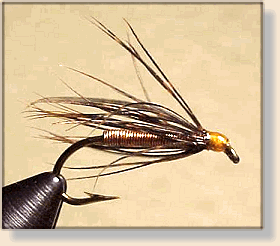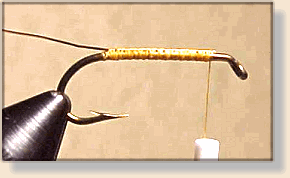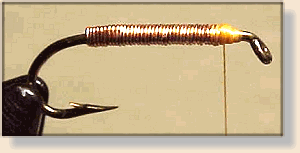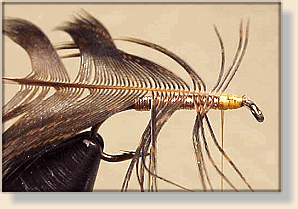
 Copper and Partridge George E. Emanuel Photos by the Author
|
|
|
|
|
Tying Steps:
1. Begin by laying a base of thread on your hook from the eye
to the barb. I have specified and use 8/0 thread on this fly as
you can get more wraps with the same bulk as a heavier thread
with fewer wraps. I firmly believe that many wraps are stronger
than a few. If you are afraid of the 8/0 thread, fall back to 6/0.
Do not try to tie this fly especially in the smaller sizes with 3/0,
it is just too heavy.
2. Lay your copper wire on top of the hook and tie in from the
rear to the front, and then to the rear and back again..
 3. Carefully lay each wrap of the copper wire directly against the adjacent wrap as you wrap the wire forward to a point about 1/8" or a tad more behind the eye. Cut the copper wire and tie it down. 4. Select a Partridge feather, or Grouse if you prefer, and carefully stroke the feathers toward the butt while holding the feather by the tip.
 5. Tie in the feather by the tip with the natural curvature of the feather facing toward the rear. The tie in point is the "v" formed where you stroked the feather rearward from the tip, and the tip itself. 6. Wind the feather around the hook shank 2 or 3 turns, placing the quill of the feather against itself on each turn, but do not overlap them. 7. Tie down the butt at the eye, and cut off the waste. 8. Tie a nice neat head, tie off the thread and cut it. 9. Using "Daves Fleximent" apply glue to the head of your fly, and let it dry. After the first coat of cement has dried, use "Black Canyon Flies" or other head cement to give your head a high gloss finish.

Notes:
For more great flies, check out: Beginning Fly Tying and Intermediate Fly Tying.
|